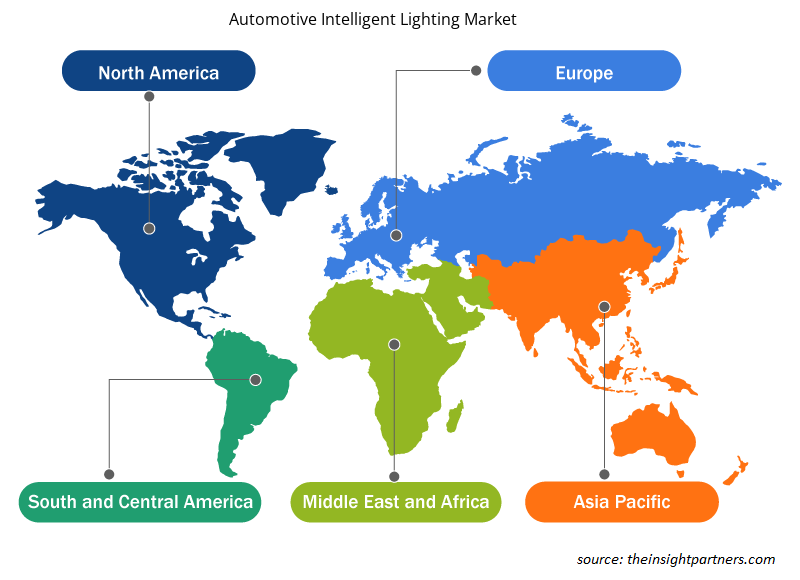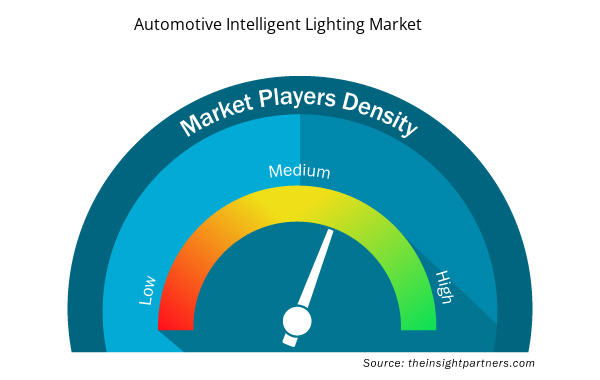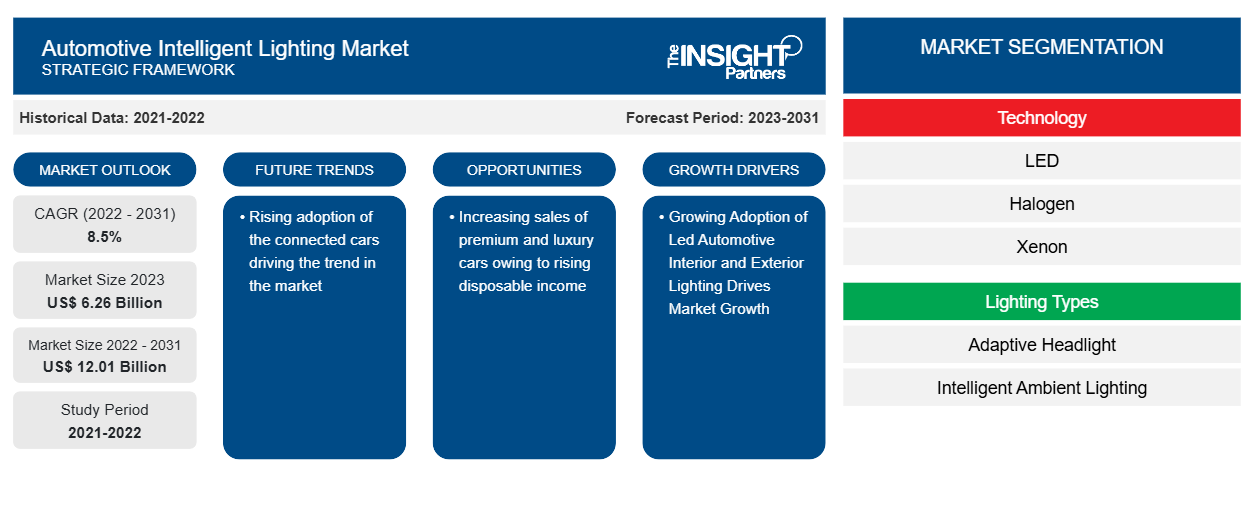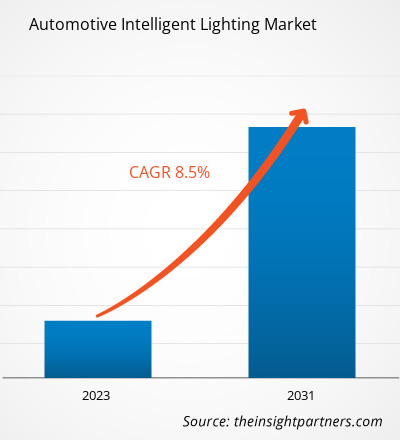自動車用インテリジェント照明の市場規模は、2023年の62億6,000万米ドルから2031年には120億1,000万米ドルに達すると予測されています。市場は2022年から2031年にかけて8.5%のCAGRを記録すると予想されています。世界中の自動車メーカーは、自社の車両にLED照明技術を急速に採用しています。自動車照明市場は、ヘッドランプ、フォーカスランプなど、いくつかの種類のLED製品で構成されています。さらに、乗用車における自動車用LED照明の採用の増加は、世界の自動車用インテリジェント照明市場の成長を牽引しています。たとえば、LED照明は、車内のインジケーターライトの約70%と計器ディスプレイのバックライトの約25%を占めています。現在、自動車用インテリジェント照明アプリケーションには、車両中央にあるストップランプとブレーキライトとテールライトが搭載されています。自動車用インテリジェント照明市場は、市場に複数の主要企業が存在するため、非常に細分化されています。
自動車用インテリジェント照明市場分析
自動車用インテリジェント LED ヘッドランプの普及率は、2023 年に最大シェアを獲得しました。コネクテッドカーの世界的な需要の高まりにより自動車販売が急速に伸びているため、2025 年までに約 65% に達すると予想されています。自動車用インテリジェント照明では、アダプティブ ドライビング ビームやアダプティブ フロントライティング システムなど、いくつかの技術が使用されています。デジタル インテリジェント自動車ランプは、高級車やプレミアムで高級な車種で利用できます。たとえば、自動車用インテリジェント照明は、マトリックス LED インテリジェントを搭載したアウディ、メルセデス ベンツ、LED インテリジェント ピクセル ヘッドランプを搭載した WEY など、いくつかのモデルに搭載されています。レーザーの輝度係数は、市場で入手可能な他の光源の約 5 倍です。したがって、レーザー ヘッドランプは、車両の運転手により広いビーム範囲を提供します。一般的なレーザー ヘッドライトのビーム範囲は 500 m を超えます。BMW i8 と BMW 7 は、レーザー統合ヘッドライトを備えた乗用車の他の車種です。
自動車用インテリジェント照明市場の概要
自動車のインテリジェント照明ソリューションが急速に採用されるにつれて、自動車 OEM は強化されたインテリジェント システムを提供しています。OEM は、消費者向けに、インテリジェント アンビエント照明を使用したアダプティブ照明や改良された室内照明などの高度なアクティブ セーフティ機能を提供しています。インテリジェント アンビエント照明やアダプティブ照明などの高度な技術が継続的に採用され、アダプティブ インジケーター、アダプティブ リア ランプ、アダプティブ パーキング ライトなど、幅広いアプリケーションが拡張されています。自動車のインテリジェント照明の成長の主な原動力は、さまざまな国で車両の安全性を確保するための厳格な政府基準によるアダプティブ照明の採用の増加と、快適で豪華なプレミアム クラスの車両に対する需要の増加です。
要件に合わせてレポートをカスタマイズする
このレポートの一部、国レベルの分析、Excelデータパックなど、あらゆるレポートを無料でカスタマイズできます。また、スタートアップや大学向けのお得なオファーや割引もご利用いただけます。
- このレポートの主要な市場動向を入手してください。この無料サンプルには、市場動向から見積もりや予測に至るまでのデータ分析が含まれます。
自動車用インテリジェント照明市場の推進要因と機会
LED自動車内装・外装照明の採用拡大が市場の成長を牽引
リアライトとフロントライトは、自動車のインテリジェント照明市場全体で最大のシェアを占めています。自動車メーカーは、燃費と安全要件を強化し、車両のパフォーマンスを向上させるために、軽量の自動車部品を統合することを目指しています。LEDインテリジェント照明は、顧客の要件に応じて安全要件を改善し、視認性を高めるために、自動車で広く使用されています。LEDランプは、他の標準的な自動車ランプと比較して、より低温で、サイズが小さく、消費電力が少なくなっています。自動車用LEDライトは、運転者が道路をよりよく見ることができ、道路の視認性を高め、それによって燃費を向上させるのに役立つヘッドライトで広く使用されています。
可処分所得の増加により高級車の販売が増加
消費者の可処分所得が莫大な先進国では、自動車人口の増加に伴い、乗用車を購入する際の消費者の嗜好が変化することが分かっています。その結果、コストと燃費はもはやこれらの自動車を購入する際の主な基準ではなく、購入は自動車に備わっている快適さと豪華さに大きく左右されるようになりました。さらに、消費者は選択の際に照明システムや車の人間工学を評価する傾向が高まっています。
自動車用インテリジェント照明市場レポートのセグメンテーション分析
自動車インテリジェント照明市場分析の導出に貢献した主要なセグメントは、テクノロジー、照明の種類、および車両の種類です。
- 技術に基づいて、世界の自動車用インテリジェント照明市場は、LED、ハロゲン、キセノン、レーザーに分かれています。これらのうち、LED技術は乗用車への採用の増加により、2023年に最大のシェアを占めます。
- 照明の種類に基づいて、世界の自動車インテリジェント照明市場は、アダプティブヘッドライトとインテリジェントアンビエント照明に分けられます。
- 車種によって市場は乗用車と商用車に分かれます。
地域別自動車用インテリジェント照明市場シェア分析
自動車インテリジェント照明市場レポートの地理的範囲は、主に北米、ヨーロッパ、アジア太平洋、中東およびアフリカ、南米の 5 つの地域に分かれています。
2023年にはアジア太平洋地域が最大のシェアを占める。これは、インド、中国、日本での乗用車の販売増加によるものである。中国では、自動車用インテリジェント照明市場は、2019年から2025年の予測期間中に約8.6%という最高のCAGRで成長している。LEDはアジア太平洋市場ではまだ普及率が低く、予測期間中に急速に成長している。これらには、広州スタンレー電気株式会社、上海小糸自動車灯有限公司、長春、ヘラ、富維自動車照明株式会社、ヴァレオ照明湖北技術センター株式会社など、いくつかの中国の自動車用インテリジェント照明企業がある。これらの主要企業は、自動車用インテリジェント照明市場の市場シェアの約60%を占めている。
自動車用インテリジェント照明市場の地域別分析
予測期間を通じて自動車インテリジェント照明市場に影響を与える地域的な傾向と要因は、Insight Partners のアナリストによって徹底的に説明されています。このセクションでは、北米、ヨーロッパ、アジア太平洋、中東、アフリカ、南米、中米にわたる自動車インテリジェント照明市場のセグメントと地理についても説明します。

- 自動車用インテリジェント照明市場の地域別データを入手
自動車用インテリジェント照明市場レポートの範囲
| レポート属性 | 詳細 |
|---|---|
| 2023年の市場規模 | 62億6千万米ドル |
| 2031年までの市場規模 | 120.1億米ドル |
| 世界のCAGR(2022年 - 2031年) | 8.5% |
| 履歴データ | 2021-2022 |
| 予測期間 | 2023-2031 |
| 対象セグメント | テクノロジー別
|
| 対象地域と国 | 北米
|
| 市場リーダーと主要企業プロフィール |
|
市場プレーヤーの密度:ビジネスダイナミクスへの影響を理解する
自動車用インテリジェント照明市場は、消費者の嗜好の変化、技術の進歩、製品の利点に対する認識の高まりなどの要因により、エンドユーザーの需要が高まり、急速に成長しています。需要が高まるにつれて、企業は提供を拡大し、消費者のニーズを満たすために革新し、新たなトレンドを活用し、市場の成長をさらに促進しています。
市場プレーヤー密度とは、特定の市場または業界内で活動している企業または会社の分布を指します。これは、特定の市場スペースに、その規模または総市場価値と比較して、どれだけの競合相手 (市場プレーヤー) が存在するかを示します。
自動車用インテリジェント照明市場で事業を展開している主要企業は次のとおりです。
- オートモーティブライティングLLC
- ヘラ社
- 株式会社小糸製作所
- ルミレッズ・ホールディングス
- オスラムコンチネンタルGmbH
- SLコーポレーション
免責事項:上記の企業は、特定の順序でランク付けされていません。

- 自動車用インテリジェント照明市場のトップキープレーヤーの概要を入手
自動車用インテリジェント照明市場のニュースと最近の動向
自動車用インテリジェント照明市場は、主要な企業出版物、協会データ、データベースなどの一次調査と二次調査後の定性的および定量的データを収集することによって評価されます。以下は、自動車用インテリジェント照明市場の市場動向と戦略のリストです。
- 2023 年 7 月、マレリはオスラムと提携し、革新的な自動車用フロント ライト h-Digi マイクロ LED モジュールを発売しました。このインテリジェントなデジタル照明ソリューションは、完全に適応型の動的なヘッドライト操作と画像投影を可能にするインテリジェントなマルチピクセル LED で構築されています。これにより、より幅広い車種で利用できるようになります。(出典: マレリ、プレス リリース/企業 Web サイト/ニュースレター)
自動車用インテリジェント照明市場レポートの対象範囲と成果物
「自動車用インテリジェント照明市場の規模と予測(2021〜2031年)」レポートでは、以下の分野をカバーする市場の詳細な分析を提供しています。
- 対象範囲に含まれるすべての主要市場セグメントの世界、地域、国レベルでの市場規模と予測
- 市場の動向(推進要因、制約、主要な機会など)
- 今後の主な動向
- 詳細なPEST分析
- 主要な市場動向、主要プレーヤー、規制、最近の市場動向を網羅した世界および地域の市場分析
- 市場集中、ヒートマップ分析、主要プレーヤー、最近の動向を網羅した業界の状況と競争分析
- SWOT分析による詳細な企業プロフィール
- 過去2年間の分析、基準年、CAGRによる予測(7年間)
- PEST分析とSWOT分析
- 市場規模価値/数量 - 世界、地域、国
- 業界と競争環境
- Excel データセット


- Precast Concrete Market
- Resistance Bands Market
- Diaper Packaging Machine Market
- Artificial Intelligence in Defense Market
- Europe Industrial Chillers Market
- Bioremediation Technology and Services Market
- Semiconductor Metrology and Inspection Market
- Biopharmaceutical Contract Manufacturing Market
- Single Pair Ethernet Market
- Nitrogenous Fertilizer Market

Report Coverage
Revenue forecast, Company Analysis, Industry landscape, Growth factors, and Trends

Segment Covered
This text is related
to segments covered.

Regional Scope
North America, Europe, Asia Pacific, Middle East & Africa, South & Central America

Country Scope
This text is related
to country scope.
Trends and growth analysis reports related to Automotive and Transportation : READ MORE..
The Insight Partners performs research in 4 major stages: Data Collection & Secondary Research, Primary Research, Data Analysis and Data Triangulation & Final Review.
- Data Collection and Secondary Research:
As a market research and consulting firm operating from a decade, we have published and advised several client across the globe. First step for any study will start with an assessment of currently available data and insights from existing reports. Further, historical and current market information is collected from Investor Presentations, Annual Reports, SEC Filings, etc., and other information related to company’s performance and market positioning are gathered from Paid Databases (Factiva, Hoovers, and Reuters) and various other publications available in public domain.
Several associations trade associates, technical forums, institutes, societies and organization are accessed to gain technical as well as market related insights through their publications such as research papers, blogs and press releases related to the studies are referred to get cues about the market. Further, white papers, journals, magazines, and other news articles published in last 3 years are scrutinized and analyzed to understand the current market trends.
- Primary Research:
The primarily interview analysis comprise of data obtained from industry participants interview and answers to survey questions gathered by in-house primary team.
For primary research, interviews are conducted with industry experts/CEOs/Marketing Managers/VPs/Subject Matter Experts from both demand and supply side to get a 360-degree view of the market. The primary team conducts several interviews based on the complexity of the markets to understand the various market trends and dynamics which makes research more credible and precise.
A typical research interview fulfils the following functions:
- Provides first-hand information on the market size, market trends, growth trends, competitive landscape, and outlook
- Validates and strengthens in-house secondary research findings
- Develops the analysis team’s expertise and market understanding
Primary research involves email interactions and telephone interviews for each market, category, segment, and sub-segment across geographies. The participants who typically take part in such a process include, but are not limited to:
- Industry participants: VPs, business development managers, market intelligence managers and national sales managers
- Outside experts: Valuation experts, research analysts and key opinion leaders specializing in the electronics and semiconductor industry.
Below is the breakup of our primary respondents by company, designation, and region:

Once we receive the confirmation from primary research sources or primary respondents, we finalize the base year market estimation and forecast the data as per the macroeconomic and microeconomic factors assessed during data collection.
- Data Analysis:
Once data is validated through both secondary as well as primary respondents, we finalize the market estimations by hypothesis formulation and factor analysis at regional and country level.
- Macro-Economic Factor Analysis:
We analyse macroeconomic indicators such the gross domestic product (GDP), increase in the demand for goods and services across industries, technological advancement, regional economic growth, governmental policies, the influence of COVID-19, PEST analysis, and other aspects. This analysis aids in setting benchmarks for various nations/regions and approximating market splits. Additionally, the general trend of the aforementioned components aid in determining the market's development possibilities.
- Country Level Data:
Various factors that are especially aligned to the country are taken into account to determine the market size for a certain area and country, including the presence of vendors, such as headquarters and offices, the country's GDP, demand patterns, and industry growth. To comprehend the market dynamics for the nation, a number of growth variables, inhibitors, application areas, and current market trends are researched. The aforementioned elements aid in determining the country's overall market's growth potential.
- Company Profile:
The “Table of Contents” is formulated by listing and analyzing more than 25 - 30 companies operating in the market ecosystem across geographies. However, we profile only 10 companies as a standard practice in our syndicate reports. These 10 companies comprise leading, emerging, and regional players. Nonetheless, our analysis is not restricted to the 10 listed companies, we also analyze other companies present in the market to develop a holistic view and understand the prevailing trends. The “Company Profiles” section in the report covers key facts, business description, products & services, financial information, SWOT analysis, and key developments. The financial information presented is extracted from the annual reports and official documents of the publicly listed companies. Upon collecting the information for the sections of respective companies, we verify them via various primary sources and then compile the data in respective company profiles. The company level information helps us in deriving the base number as well as in forecasting the market size.
- Developing Base Number:
Aggregation of sales statistics (2020-2022) and macro-economic factor, and other secondary and primary research insights are utilized to arrive at base number and related market shares for 2022. The data gaps are identified in this step and relevant market data is analyzed, collected from paid primary interviews or databases. On finalizing the base year market size, forecasts are developed on the basis of macro-economic, industry and market growth factors and company level analysis.
- Data Triangulation and Final Review:
The market findings and base year market size calculations are validated from supply as well as demand side. Demand side validations are based on macro-economic factor analysis and benchmarks for respective regions and countries. In case of supply side validations, revenues of major companies are estimated (in case not available) based on industry benchmark, approximate number of employees, product portfolio, and primary interviews revenues are gathered. Further revenue from target product/service segment is assessed to avoid overshooting of market statistics. In case of heavy deviations between supply and demand side values, all thes steps are repeated to achieve synchronization.
We follow an iterative model, wherein we share our research findings with Subject Matter Experts (SME’s) and Key Opinion Leaders (KOLs) until consensus view of the market is not formulated – this model negates any drastic deviation in the opinions of experts. Only validated and universally acceptable research findings are quoted in our reports.
We have important check points that we use to validate our research findings – which we call – data triangulation, where we validate the information, we generate from secondary sources with primary interviews and then we re-validate with our internal data bases and Subject matter experts. This comprehensive model enables us to deliver high quality, reliable data in shortest possible time.


 このレポートの無料サンプルを入手する
このレポートの無料サンプルを入手する